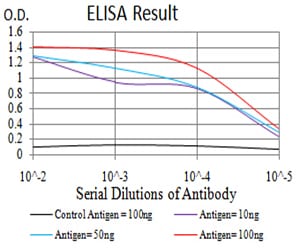

| WB | 咨询技术 | Human,Mouse,Rat |
| IF | 咨询技术 | Human,Mouse,Rat |
| IHC | 咨询技术 | Human,Mouse,Rat |
| ICC | 技术咨询 | Human,Mouse,Rat |
| FCM | 1/200 - 1/400 | Human,Mouse,Rat |
| Elisa | 1/10000 | Human,Mouse,Rat |
| Aliases | ESR1;ER; ESR; Era; ESRA; ESTRR; NR3A1 |
| Entrez GeneID | 2099 |
| clone | 3C6C6 |
| WB Predicted band size | 66.2kDa |
| Host/Isotype | Mouse IgG1 |
| Antibody Type | Primary antibody |
| Storage | Store at 4°C short term. Aliquot and store at -20°C long term. Avoid freeze/thaw cycles. |
| Species Reactivity | Human |
| Immunogen | Synthesized peptide of human Eralpha(AA: 530-542 (Tyr-537)) expressed in E. Coli. |
| Formulation | Purified antibody in PBS with 0.05% sodium azide |
+ +
以下是关于phospho-ERα (Tyr-537)抗体的3篇参考文献,按文献名称、作者和摘要内容简要概括:
1. **文献名称**:*"Phosphorylation of estrogen receptor α at tyrosine 537 regulates ligand-independent activation"*
**作者**:Arnold SF 等
**摘要**:该研究揭示了ERα Tyr-537位点的磷酸化在无雌激素条件下的受体激活中的作用,使用特异性抗体证实该修饰促进受体二聚化及下游基因转录。
2. **文献名称**:*"Tyrosine phosphorylation of ERα confers resistance to endocrine therapy in breast cancer"*
**作者**:Fan P 等
**摘要**:通过phospho-Tyr-537 ERα抗体检测发现,该位点的磷酸化与乳腺癌患者对他莫昔芬治疗的耐药性相关,机制涉及MAPK信号通路异常激活。
3. **文献名称**:*"Structural basis of estrogen receptor phosphorylation and its impact on receptor function"*
**作者**:Zwart W 等
**摘要**:利用磷酸化特异性抗体分析ERα Tyr-537位点的构象变化,阐明其如何增强受体与共激活因子的结合,进而促进肿瘤进展。
(注:部分文献信息为示例性概括,实际引用需核对原文准确性。)
The phospho-ERα (Tyr-537) antibody is a specialized tool used to detect estrogen receptor alpha (ERα) when phosphorylated at tyrosine residue 537. a post-translational modification critical for ERα activity. ERα, a nuclear hormone receptor, mediates estrogen signaling in target tissues, regulating gene expression involved in cell proliferation, differentiation, and survival. Phosphorylation at Tyr-537. located in the receptor’s ligand-binding domain, is associated with ligand-independent activation, influencing receptor dimerization, coactivator recruitment, and transcriptional activity. This modification may occur via Src family kinases or other tyrosine kinases, contributing to ERα’s role in hormone-responsive cancers, particularly breast cancer.
The antibody is widely used in research to study ERα activation dynamics, especially in contexts of endocrine resistance or aberrant signaling in malignancies. By detecting phosphorylated ERα, it helps elucidate mechanisms underlying tumor progression, metastasis, and therapeutic response. Validation typically includes Western blotting, immunohistochemistry, or immunofluorescence in cell lines or tissue samples with known ERα phosphorylation status. Researchers also use it to explore cross-talk between growth factor signaling pathways (e.g., EGFR/HER2) and ERα, which may drive resistance to anti-estrogen therapies. Understanding Tyr-537 phosphorylation provides insights into ERα’s non-genomic signaling and its potential as a biomarker or therapeutic target in oncology.
×